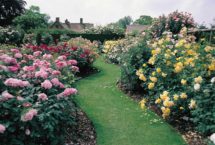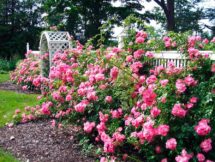Damask rose belongs to the group of old roses and stands out among its relatives by long branching shoots, which are strewn with flowering double buds of bright light shades, exuding an exquisite aroma.
Material Content:
Description of varieties and nuances of growing
Damask roses are of natural origin and have been known for a very long time. In the 13th century they were brought to Europe from Persia, the city of Damascus, which served as the basis for the formation of their specific name.
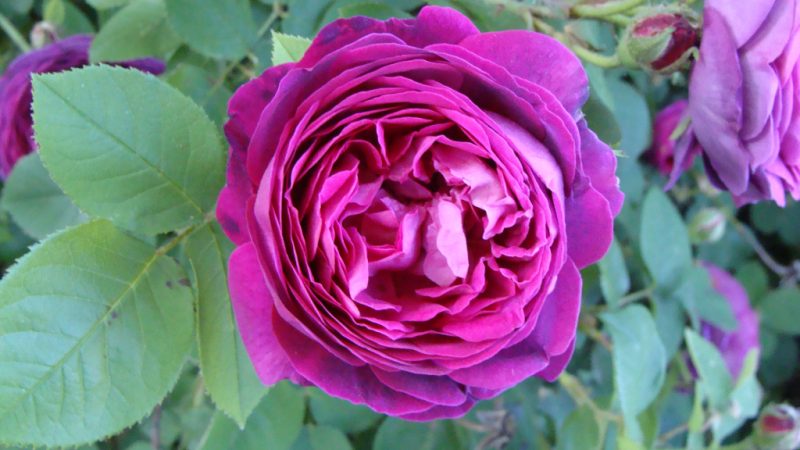
Today this group of plants is represented by a large number of hybrids that differ both externally and some features of vegetation.
In Russia, the most common varieties of damask roses, combining high decorativeness with relative unpretentiousness:
- Ispahan ("Ispahan") - a variety famous for its rich aroma of densely double buds, painted in bright pink and scarlet tones, and bluish-green foliage. Roses "Ispahan" are thermophilic and need good care.
- Madame Hardy ("Madame Hardy") is a hybrid with long (up to 2 m) lodging shoots, with large leaves and tassels of double flowers, painted white and exuding a strong, with hints of lemon, aroma. Madame Hardy roses are shade-hardy, frost-resistant and rarely sick. Moreover, they are demanding on the composition of soils and need support.
- Celsiana plants are characterized by early flowering, accompanied by the formation of semi-double, slightly "tousled" buds of delicate pink colors, and beautiful foliage. It grows well on poorly fertile soils. In the middle lane it needs winter shelter.
- Duc de Cambridge ("Duke de Cambridge") - a variety of spreading shrubs of medium (1.5 m) height with inflorescences from large (up to 10 cm) terry buds of pink shades.It differs in the duration of flowering and endurance.
- Variety Marie Louise ("Marie Louise") is a culture with strong shoots covered with matte ellipsoid leaves of dark green hues and small (3-4 cm) densely-colored flowers of lilac-pink hues.
- Hybrids Damascena Trigintipetala ("Damascene Trigintipetala") have high strong shoots to which small oval leaves of light green tones with a wrinkled surface are attached. Cup-shaped terry nimbuses are painted in pink, with a white core, colors. The variety grows well in the shade, is cold-hardy and hardy.
- The shoots of rosa damascena of the York and Lancaster variety (York and Lancaster) are covered with pubescent gray-green leaves with rounded sharp peaks and bear double flowers with pink petals in raspberry spots. The variety is shade-hardy and winter-hardy, rarely sick and damaged by pests.
Choosing Healthy Seedlings When Purchasing
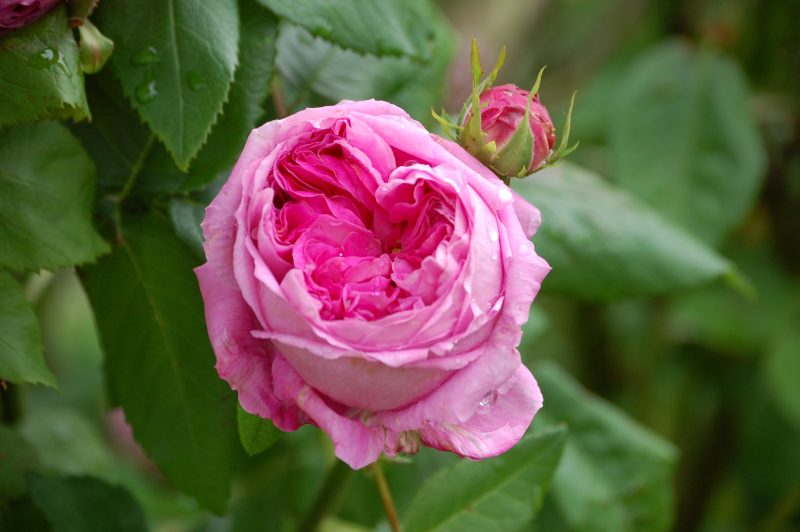
There are several types of rose seedlings for sale:
- in fact, root and grafted;
- with a closed and open root system.
The grafted young plants are easily recognizable by the characteristic suture formed at the site of vaccination.
They take root better and are more unpretentious, but if improperly planted, they can die due to rejection of the dogrose stock. Cases and their degeneration are frequent.
Actually, root seedlings are more sensitive to adverse climate conditions and demanding care. Therefore, acquiring them, it is important to choose an initially healthy plant.
It is better if it is a one- or two-year hybrid in a container, having:
- root neck with a diameter of at least 8 - 10 cm;
- 2 or 3 lignified shoots of dark green color without spots and plaque;
- at least 3 sleeping kidneys.
Damask rose planting in open ground
Damask roses in the middle band are best planted in spring. In areas with warm winters, roses can be planted in the fall, in September. Before the onset of cold weather, plants must have time to root and grow stronger.

An important moment of landing is the choice of a place, which is carried out on the basis of 2 criteria:
- Illumination. Damask roses do not tolerate direct sunlight: their leaves dry up and wither, buds become smaller and burn out. Most representatives are not comfortable in the shade: they bloom poorly or even refuse to do this, often get sick. An ideal accommodation option would be to choose southeastern, eastern, southwestern or western sections, excluding the presence of drafts and the proximity to trees and other shrubs.
- The composition and properties of the soil. Damask roses need moderately moist fertile and loose lands with a neutral or slightly acidic environment.
Spring planting is carried out after the soil warms up to 15 ° C.
Adhere to the following scheme:
- In advance, they dig indentations, the size of which is determined by the volume of the root system of the seedling (on average, from 35 to 50 cm in width and depth). When planting several bushes, the recesses are placed at a distance of about 70 cm.
- Immediately before planting, the seedling is carefully inspected, all rotted and dry sections of the roots are removed, too long are shortened to 20-30 cm.
- The roots of a seedling for 2 hours are placed in a solution of a drug that activates tissue growth, for example, "Kornevina".
- At the bottom of the landing pit lay a nutrient mixture made up of equal parts of humus or humus and sod land.
- A sapling is placed in the recess and its roots are straightened.
- Sprinkle the plant with earth, deepening the root neck or vaccination site by 4 - 5 cm.
After planting, the soil around the shoots is compacted. The seedling is abundantly watered and mulched with sawdust or peat.
Proper planting of a healthy seedling and its successful placement will greatly simplify the care of plants.
How to care for flowers
Caring for damask roses is simple and consists of several procedures.
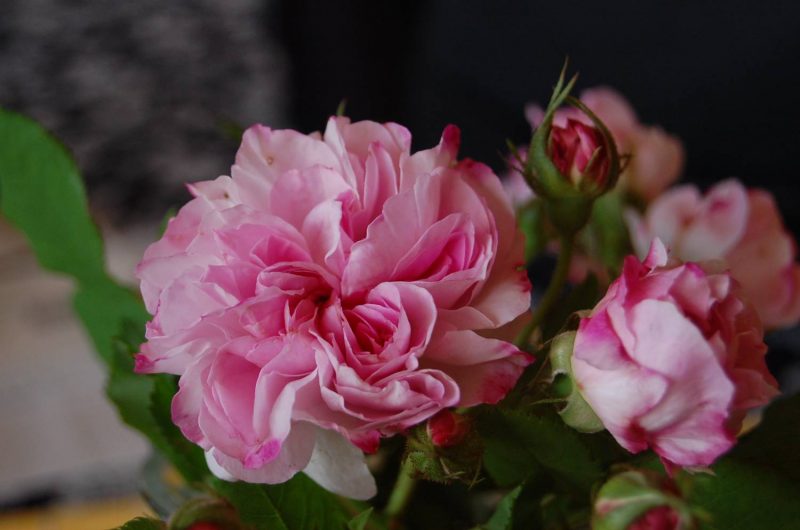
It:
- Watering. Roses are watered in the morning or evening, using water heated in the sun.The frequency of humidification is determined by the state of the topsoil - it must completely dry. According to averaged data, in the summer they water it once a week, in the heat - 2 times. At least a bucket of water is poured under each bush, trying not to fall on the leaves. By the end of summer, moisturizing is gradually reduced.
- Mulching. It is carried out in order to preserve moisture, protect the soil from overheating and the appearance of weeds. As mulch, humus, peat, sawdust, grass or fallen leaves are used with a layer of 10 cm. As the mulch dries, the mulch is updated.
- Shelter for the winter. Many varieties of damask roses survive the winter well without shelter, but it is better not to take risks and protect the plants by pouring 10-15 cm of land or peat under the bush. In regions with frosty winters, shoots are bent to the ground in autumn and covered with fir spruce branches.
- Prevention of diseases and pests. Damascus roses are often affected by fungi and attract sucking insects, therefore several times during the season the bushes are treated with folk remedies (infusion of garlic, tobacco) for preventive purposes, and with high risk of diseases - fungicides (Fitosporin, Alirin) and drugs that increase immunity plants (succinic acid).
Read also:succinic acid for plants
Fertilizers are applied several times during the season, in dry form before watering:
- in the spring, during the growth of shoots and leaves - 30 g of Nitroammofoski for each bush;
- during budding - a mixture of 30 g of superphosphate, 15 g of nitrate, 20 g of potassium salt;
- during flowering - mullein and ash.
Pruning is carried out in the first year after planting in order to form a bush and maintain its decorativeness.
In the future, only sanitary scraps are carried out:
- In early spring, all dried and weakened branches are removed. Strong shoots are pruned, leaving a maximum of 8 buds.
- In summer they get rid of weak growths, dried up or broken branches.
- In the fall, strong shoots are shortened by 5 - 10 cm.
With proper and regular care, roses will delight others with their fragrant flowering for a long time.
Use in landscape design
Damascus roses have long been used as decorations for parks, gardens and flower beds:
- sprawling bushes are effective both in single plantings and in groups;
- ideal for vertical gardening, forming hedges, decorating arches and arbors;
- widely used for zoning sites;
- look picturesque as part of landscape compositions and mixborders.
Everywhere, wherever damask roses grow, the air is filled with a subtle strong aroma that enhances the spectacular perception of these plants. This odor composition is widely used in perfumery and cosmetology, and Damask rose oil, obtained from its petals, is famous for its healing rejuvenating properties.



